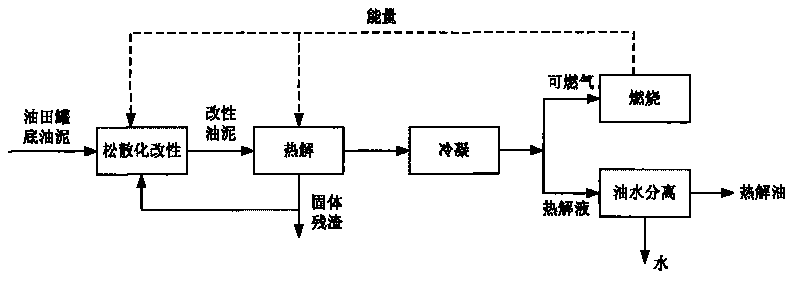Reclamation treatment method of oil field tank bottom oil sludge
A treatment method and sludge technology, applied in the pyrolysis treatment of sludge, by-product vaporization, etc., can solve the problems of oily sludge property fluctuation, large mass transfer performance, poor treatment effect, unstable operation, etc. quality, improving mass transfer performance, and avoiding operational failures
- Summary
- Abstract
- Description
- Claims
- Application Information
AI Technical Summary
Problems solved by technology
Method used
Image
Examples
Embodiment 1
[0041] The ratio of oily sludge, sand, oil and water in an oilfield tank bottom is 68.27:22.71:9.21.
[0042] Heat the oilfield tank bottom sludge to 150°C, add 5% solid residue with a particle size of less than 1mm, and carry out loosening and modification in a twin-shaft mixer; the modified sludge enters a paddle-type pyrolysis furnace and heats up at 500°C The reaction time is 45 minutes, and the solid residue is discharged from the furnace; the condensed liquid obtained by the condensation of the precipitated gas is added with concentrated sulfuric acid as a demulsifier, and the pyrolysis oil is separated; the combustible gas is burned to provide heat for the system. As a result of the reaction, 0.13 tons of pyrolysis oil, 0.07 tons of combustible gas and 0.80 tons of solid residue can be produced for every ton of oilfield tank bottom sludge treated. The treatment reduction rate reaches 20%. From the perspective of oil conversion in sludge, 57% of the oil is converted int...
Embodiment 2
[0044] The mass ratio of the oilfield tank bottom sludge, sand, oil and water components in an oilfield is: 54.26:39.12:6.62.
[0045] Heat the oilfield tank bottom sludge to 150°C, add 5% solid residue with a particle size of less than 1mm, and carry out loosening and modification in a twin-shaft mixer; the modified sludge enters a paddle-type pyrolysis furnace and heats up at 550°C The reaction time is 30 minutes, and the solid residue is discharged from the furnace; the condensed liquid obtained by the condensation of the precipitated gas is added with concentrated sulfuric acid as a demulsifier, and the pyrolysis oil is separated; the combustible gas is burned to provide heat for the system. As a result of the reaction, 0.25 tons of pyrolysis oil, 0.08 tons of combustible gas and 0.67 tons of solid residue can be produced for every ton of oilfield tank bottom sludge treated. The treatment reduction rate reached 33%. In terms of oil conversion in sludge, 64% of the oil is ...
PUM
 Login to View More
Login to View More Abstract
Description
Claims
Application Information
 Login to View More
Login to View More - R&D
- Intellectual Property
- Life Sciences
- Materials
- Tech Scout
- Unparalleled Data Quality
- Higher Quality Content
- 60% Fewer Hallucinations
Browse by: Latest US Patents, China's latest patents, Technical Efficacy Thesaurus, Application Domain, Technology Topic, Popular Technical Reports.
© 2025 PatSnap. All rights reserved.Legal|Privacy policy|Modern Slavery Act Transparency Statement|Sitemap|About US| Contact US: help@patsnap.com


